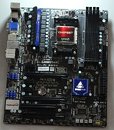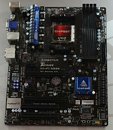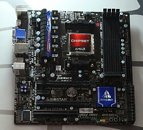- Joined
- Oct 9, 2007
- Messages
- 47,647 (7.44/day)
- Location
- Dublin, Ireland
| System Name | RBMK-1000 |
|---|---|
| Processor | AMD Ryzen 7 5700G |
| Motherboard | Gigabyte B550 AORUS Elite V2 |
| Cooling | DeepCool Gammax L240 V2 |
| Memory | 2x 16GB DDR4-3200 |
| Video Card(s) | Galax RTX 4070 Ti EX |
| Storage | Samsung 990 1TB |
| Display(s) | BenQ 1440p 60 Hz 27-inch |
| Case | Corsair Carbide 100R |
| Audio Device(s) | ASUS SupremeFX S1220A |
| Power Supply | Cooler Master MWE Gold 650W |
| Mouse | ASUS ROG Strix Impact |
| Keyboard | Gamdias Hermes E2 |
| Software | Windows 11 Pro |
Biostar is ready with a trio of socket FM2 motherboards, based on AMD's new A85 FCH chipset, the higher-end Hi-Fi A85X, mid-range Hi-Fi A85W, and value Hi-Fi A85S. Biostar implemented some of its latest innovations on the two. To begin with, the thee feature Hi-Fi amplifiers for the analog channels of the onboard audio. Another innovative feature with the two is a bank of capacitors that make the board electrostatic discharge proof up to 15,000V. Find the furriest carpet to assemble your rig on.
The audio solution combines a high SNR CODEC (probably ALC898) with an OPAMP circuitry that uses sound card grade electrolytic capacitors. The entire audio portion of the motherboard, including the rear panel jack cluster and front-panel headers, have a ground PCB layer of their own, that is isolated from the ground layer of the rest of the board. This ensures there's no ground layer interference from other high-current components on the board, a problem common with onboard audio solutions.



The Hi-Fi A85X is designed to occupy a premium price point. It uses a 10-phase VRM to power the APU, which is wired to four DDR3 DIMM slots, supporting up to 32 GB of dual-channel DDR3-2400+ MHz memory, and two PCI-Express 2.0 x16 slots (x8/x8, when both are populated). Other expansion slots include a PCI-Express 2.0 x16 (electrical x4, wired to the FCH), three PCI-Express 2.0 x1, and a legacy PCI. Out of the eight SATA 6 Gb/s ports given out by the A85 FCH, seven are assigned as internal ports, and one eSATA. Display outputs include DVI, D-Sub, HDMI, and DisplayPort. The Hi-Fi audio solution (detailed above), four USB 3.0 ports, and gigabit Ethernet make for the rest of the connectivity. The board is driven by AMI UEFI BIOS.
Moving on to the more affordable Hi-Fi A85W, which retains the two star features of its sibling, the board uses a simpler 6-phase VRM to power the FM2 socket. It supports up to 32 GB of dual-channel DDR3-2400+ MHz memory, and although it has two PCI-Express x16 slots, only one of them is wired to the APU socket, and is PCI-Express 2.0 x16. The other is electrical x4, wired to the FCH. The board has all eight SATA 6 Gb/s ports from the PCH arranged in a neat row of internal ports. Display outputs include DVI, HDMI, and D-Sub. The Hi-Fi audio solution, apart from gigabit Ethernet, and four USB 3.0 ports, make for the rest of it. AMI UEFI BIOS drives the Hi-Fi A85W, too.
Lastly, there's the Hi-Fi A85S, the lone micro-ATX motherboard among the three. This one uses the same 6-phase VRM as the Hi-Fi A85W, to power the APU. Like the others, it supports up to 32 GB of dual-channel DDR3-2400+ MHz memory. Expansion slots include one PCI-Express 2.0 x16 wired to the APU, a PCI-Express 2.0 x16 (electrical x4) wired to the FCH, a PCI-Express 2.0 x1, and a legacy PCI. Like with the A85W, all eight SATA 6 Gb/s ports from the FCH are wired as internal ports. DVI, D-Sub, and HDMI handle display outputs. A 6-channel variation of the Hi-Fi audio, gigabit Ethernet, and four USB 3.0 ports make for the rest of it.
The three will feature in Biostar's first wave of socket FM2 motherboards.
View at TechPowerUp Main Site
The audio solution combines a high SNR CODEC (probably ALC898) with an OPAMP circuitry that uses sound card grade electrolytic capacitors. The entire audio portion of the motherboard, including the rear panel jack cluster and front-panel headers, have a ground PCB layer of their own, that is isolated from the ground layer of the rest of the board. This ensures there's no ground layer interference from other high-current components on the board, a problem common with onboard audio solutions.



The Hi-Fi A85X is designed to occupy a premium price point. It uses a 10-phase VRM to power the APU, which is wired to four DDR3 DIMM slots, supporting up to 32 GB of dual-channel DDR3-2400+ MHz memory, and two PCI-Express 2.0 x16 slots (x8/x8, when both are populated). Other expansion slots include a PCI-Express 2.0 x16 (electrical x4, wired to the FCH), three PCI-Express 2.0 x1, and a legacy PCI. Out of the eight SATA 6 Gb/s ports given out by the A85 FCH, seven are assigned as internal ports, and one eSATA. Display outputs include DVI, D-Sub, HDMI, and DisplayPort. The Hi-Fi audio solution (detailed above), four USB 3.0 ports, and gigabit Ethernet make for the rest of the connectivity. The board is driven by AMI UEFI BIOS.
Moving on to the more affordable Hi-Fi A85W, which retains the two star features of its sibling, the board uses a simpler 6-phase VRM to power the FM2 socket. It supports up to 32 GB of dual-channel DDR3-2400+ MHz memory, and although it has two PCI-Express x16 slots, only one of them is wired to the APU socket, and is PCI-Express 2.0 x16. The other is electrical x4, wired to the FCH. The board has all eight SATA 6 Gb/s ports from the PCH arranged in a neat row of internal ports. Display outputs include DVI, HDMI, and D-Sub. The Hi-Fi audio solution, apart from gigabit Ethernet, and four USB 3.0 ports, make for the rest of it. AMI UEFI BIOS drives the Hi-Fi A85W, too.
Lastly, there's the Hi-Fi A85S, the lone micro-ATX motherboard among the three. This one uses the same 6-phase VRM as the Hi-Fi A85W, to power the APU. Like the others, it supports up to 32 GB of dual-channel DDR3-2400+ MHz memory. Expansion slots include one PCI-Express 2.0 x16 wired to the APU, a PCI-Express 2.0 x16 (electrical x4) wired to the FCH, a PCI-Express 2.0 x1, and a legacy PCI. Like with the A85W, all eight SATA 6 Gb/s ports from the FCH are wired as internal ports. DVI, D-Sub, and HDMI handle display outputs. A 6-channel variation of the Hi-Fi audio, gigabit Ethernet, and four USB 3.0 ports make for the rest of it.
The three will feature in Biostar's first wave of socket FM2 motherboards.
View at TechPowerUp Main Site





